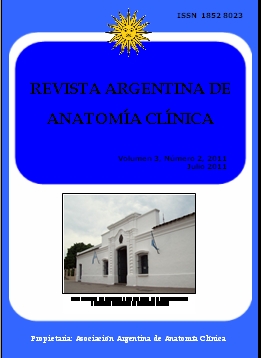ANOMALOUS ORIGIN OF OCCIPITOAURICULAR TRUNK FROM EXTERNAL CAROTID ARTERY. Origen anomalo del tronco occipito-auricular de la arteria carotida externa
DOI:
https://doi.org/10.31051/1852.8023.v3.n2.13927Keywords:
External carotid artery, occipito-auricular trunk, arteria carótida externa, el tronco occipito-auricularAbstract
Las anomalías en el origen y patrón de ramificación de la arteria carótida externa (ACE) son comunes. El nivel de la bifurcación de la arteria carótida común (ACC) y las variaciones en el origen / patrón de ramificación de la arteria carótida externa están bien documentados. En el hallazgo de las arterias occipitales y posteriores surgían de un corto tronco común de la ACE en el lado izquierdo. El conocimiento de las variaciones en el origen y curso de las ramas de la ACE son de suma importancia en la cirugía. Los cirujanos deben ser conscientes de la posibilidad de encontrar estas variaciones, ya que pueden conducir a dificultades en la distinción de las ramas de la arteria carótida externa. Este conocimiento es también importante para los radiólogos en la interpretación de las imágenes de las regiones de la cara y el cuello.
Anomalies in the origin and branching pattern of the external carotid artery (ECA) are common. The level of the bifurcation of the common carotid artery (CCA) and the variations in the origin/branching pattern of the external carotid artery are well documented. In the present finding occipital and posterior auricular arteries were arising by a short common trunk from ECA on the left side. Knowledge of variations in the origin and course of branches of ECA is of importance in surgery. Surgeons need to be aware of the possibility of encountering such variations, as they may lead to difficulties in differentiating the branches of external carotid artery. This knowledge is also important for radiologists in the image interpretation of the face and neck regions.
References
Adachi B, Hasebe K. 1928. Das Arteriensystem der Japaner. Kyobo, Maruzen, Kaiserlich Japanischen Universitat zu Kyoto, V.1, 58-96.
Altmann F. 1947. Anomalies of the internal carotid artery and its branches: Their Embryological and Comparative Anatomical Significance. Report of a New Case of Persistent Stapedial Artery in Man. Laryngoscope. 57:c313-39.
Anil A, Turgut HB, Peker T, Pelin C. 2000.Variations of the branches of the external carotid artery. Gazi Med J; 11: 81-3.
Benson MT, Hamer JD. 1988. Anomalous origin of the occipital artery from the cervical internal carotid artery. J. Vasc. Surg. 8: 643-5.
Gluncic V, Petanjek Z, Marusic A, Gluncic I. 2001.High bifurcation of common carotid artery, anomalous origin of ascending pharyngeal artery and anomalous branching pattern of external carotid artery. Surg. Radiol. Anat 23: 123-5.
Kaneko K, Akita M, Murata E, Imai M, Sowa K. 1996. Unilateral anomalous left common carotid artery: a case report. Ann. Anat., 178: 477-80.
Lasjaunias P, Théron J, Moret J. 1978.The occipital artery. Neuroradiology, 15: 31-7.
Lippert H, Pabst R. 1985. Arterial variations in man. Classification and frequency. JF Bergman Verlag: Minchen, 84
Matloub HS, Yousif NJ, Ye Z, Sanger JR. 1992. The occipital artery flap for transfer of hair-bearing tissue. Annals of Plastic Surgery, 29: 491-5
Matsuda I, Handa J, Handa H, Mizunom H. 1977. Bilateral anomalous occipital artery of internal carotid origin: case report. Nippon Geka Hokan.46: 57-61.
Newton TH, Young DA. 1968. Anomalous origin of the occipital artery from the internal carotid artery. Radiology 90: 550-2.
Schmidt D, Aldemann G. 2001. The course of the occipital artery? An anatomical investigation for biopsy in suspected vasculitis. European J. Med. Research, 6: 235-41.
Sharma R K, Kobayashi K, Jackson IT, Carls FR. 1996. Vascular anatomy of the galea occipitalis flap: a cadaver study. Plastic and Reconstructive Surgery, 97: 25-31.
Standring S, Johnson D, Collins P, Mahadevan V. 2008.Gray’s Anatomy, 40th edition, Churchill Livingstone, London, 446-447.
Takenoshita H. 1983. Case of hypoplasia of the internal carotid artery associated with persistent primitive hypoglossal artery. Kaibogaku Zasshi; 58: 533-50.
Thwin SS, Soe MM, Myint M, Than M, Lwin S. 2010. Variations of the origin and branches of the external carotid artery in a human cadaver. Singapore Med J 51:e40–e42.
Zumre O, Salbacak A, Cicekcibasi AE, Tuncer I, Seker M. 2005. Investigation of the bifurcation level of the common carotid artery and variations of the branches of the external carotid artery in human fetuses. Ann Anat. 187: 361-69.
Downloads
Published
Issue
Section
License
Authors retain copyright and grant the journal right of first publication with the work simultaneously licensed under a Creative Commons Attribution License that allows others to share the work with an acknowledgement of the work's authorship and initial publication in this journal. Use restricted to non commercial purposes.
Once the manuscript has been accepted for publications, authors will sign a Copyright Transfer Agreement to let the “Asociación Argentina de Anatomía Clínica” (Argentine Association of Clinical Anatomy) to edit, publish and disseminate the contribution.



